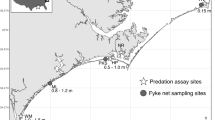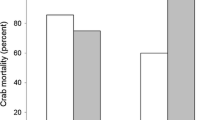Abstract
Nested scales of habitat heterogeneity may independently or synergistically influence faunal interactions. Fragmentation effects (i.e., the breaking apart of landscapes) and edge effects (i.e., ecological differences between edges and interiors of patches, nested within landscapes) are distinct yet related ecological concepts, linked mathematically by the habitat edge-to-area ratio. Our study quantified the separate and interactive effects of fragmentation and edge on predation using temperate seagrass. To assess how predation and generalized consumption were influenced by fragmentation state (i.e., continuous, fragmented), and proximity to edge (i.e., edges, interiors), we used tethering assays with two prey-items: juvenile crabs, Callinectes sapidus, and “squidpops” (dried squid mantle). We also investigated whether faunal densities (a proxy for consumption potential) and temperature (a proxy for a broad suite of seasonal changes) correlated with predation across landscapes. Results showed fragmentation state affected predation (i.e., crab) mortality, yet edge effects did not. Moreover, the directionality of fragmentation effects shifted across a temperature/seasonal gradient. Predation mortality more than doubled in continuous landscapes amidst temperature increases, surpassing initially higher mortality in fragmented landscapes, which did not systematically vary with temperature. This mortality magnitude “flip” matched spatiotemporal trends in faunal densities between continuous and fragmented meadows. Consumption rates of both prey-items increased alongside temperature and neither demonstrated edge effects. However, crabs showed fragmentation effects not seen with squidpops, suggesting differing foraging strategies used by consumers of these prey-items. We conclude that fragmentation and edge effects have dynamic influences on temperate predator–prey interactions, as faunal favorability of habitat heterogeneity can “flip” temporally.



Similar content being viewed by others
References
Baillie CJ, Fear JM, Fodrie FJ (2015) Ecotone effects on seagrass and saltmarsh habitat use by juvenile nekton in a temperate estuary. Estuar Coasts 38:1414–1430. https://doi.org/10.1007/s12237-014-9898-y
Banikas EM, Thompson JS (2012) Predation risk experienced by mummichog, Fundulus heteroclitus, in intertidal and subtidal salt marsh habitats. Estuar Coasts 35:1346–1352. https://doi.org/10.1007/s12237-012-9517-8
Becker A, Coppinger C, Whitfield AK (2012) Influence of tides on assemblages and behaviour of fishes associated with shallow seagrass edges and bare sand. Mar Ecol Prog Ser 456:187–199. https://doi.org/10.3354/meps09695
Bell JD, Westoby M (1986) Abundance of macrofauna in dense seagrass is due to habitat preference, not predation. Oecologia 68:205–209. https://doi.org/10.1016/S0367-2530(17)30741-7
Bell SS, Brooks RA, Robbins BD, Fonseca MS, Hall MO (2001) Faunal response to fragmentation in seagrass habitats: implications for seagrass conservation. Biol Conserv 100:115–123. https://doi.org/10.1016/S0006-3207(00)00212-3
Blanchard GF, Guarini JM, Gros P, Richard P (1997) Seasonal effect on the relationship between the photosynthetic capacity of intertidal microphytobenthos and temperature. J Phycol 33:723–728. https://doi.org/10.1111/j.0022-3646.1997.00723.x
Boström C, Jackson EL, Simenstad CA (2006) Seagrass landscapes and their effects on associated fauna: a review. Est Coast Shelf Sci 68:383–403. https://doi.org/10.1016/j.ecss.2006.01.026
Boström C, Pittman SJ, Simenstad C, Kneib RT (2011) Seascape ecology of coastal biogenic habitats: advances, gaps, and challenges. Mar Ecol Prog Ser. https://doi.org/10.3354/meps09051
Cote D, Gregory RS, Morris CJ, Newton BH, Schneider DC (2013) Elevated habitat quality reduces variance in fish community composition. J Exp Mar Biol Ecol. https://doi.org/10.1016/j.jembe.2012.11.006
Duffy JE, Ziegler SL, Campbell JE, Bippus PM, Lefcheck JS (2015) Squidpops: a simple tool to crowdsource a global map of marine predation intensity. PLoS ONE 10:e0142994. https://doi.org/10.1371/journal.pone.0142994
Fahrig L (1998) When does fragmentation of breeding habitat affect population survival? Ecol Model 105:273–292. https://doi.org/10.1016/S0304-3800(97)00163-4
Fahrig L (2003) Effects of habitat fragmentation on biodiversity. Annu Rev Ecol Evol S 34:487–515. https://doi.org/10.1146/annurev.ecolsys.34.011802.132419
Fahrig L (2013) Rethinking patch size and isolation effects: the habitat amount hypothesis. J Biogeogr 40:1649–1663. https://doi.org/10.1111/jbi.12130
Feierabend D, Kielland K (2015) Seasonal effects of habitat on sources and rates of snowshoe hare predation in Alaskan boreal forests. PLoS ONE 10:e0143543
Fox J, Weisberg S (2011) An {R} companion to applied regression, 2nd edn. Thousand Oaks: Sage. https://socserv.socsci.mcmaster.ca/jfox/Books/Companion
Haddad NM, Brudvig LA, Clobert J, Davies KF, Gonzalez A, Holt RD, Lovejoy TE, Sexton JO, Austin MP, Collins CD, Cook WM, Damschen EI, Ewers RM, Foster BL, Jenkins CN, King AJ, Laurance WF, Levey DJ, Margules CR, Melbourne BA, Nicholls AO, Orrock JL, Song D, Townshend JR (2015) Habitat fragmentation and its lasting impact on Earth’s ecosystems. Sci Adv 1:e1500052. https://doi.org/10.1126/sciadv.1500052
Hovel KA, Fonseca MS (2005) Influence of seagrass landscape structure on the juvenile blue crab habitat-survival function. Mar Ecol Prog Ser 300:179–191. https://doi.org/10.3354/meps300179
Hovel KA, Lipcius RN (2001) Habitat fragmentation in a seagrass landscape: patch size and complexity control blue crab survival. Ecology 82:1814–1829. https://doi.org/10.1890/0012-9658(2001)082[1814:HFIASL]2.0.CO;2
Hovel KA, Lipcius RN (2002) Effects of seagrass habitat fragmentation on juvenile blue crab survival and abundance. J Exp Mar Biol Ecol 271:75–98. https://doi.org/10.1016/S0022-0981(02)00043-6
Howell DC (1998) Statistical methods in human sciences. Wadsworth, New York
Iriarte A, Aravena G, Villate F, Uriarte I, Ibenaz B, Llope M, Stenseth NC (2010) Dissolved oxygen in contrasting estuaries of the Bay of Biscay: effects of temperature, river discharge and chlorophyll a. Mar Ecol Prog Ser 418:57–71. https://doi.org/10.3354/meps08812
Jankowska E, Włodarska-Kowalczuk M, Kotwicki L, Balazy P, Kuliński K (2014) Seasonality in vegetation biometrics and its effects on sediment characteristics and meiofauna in Baltic seagrass meadows. Estuar Coast Shelf Sci. https://doi.org/10.1016/j.ecss.2014.01.003
Laurance WF (2008) Theory meets reality: How habitat fragmentation research has transcended island biogeography theory. Biol Conserv 141:1731–1744. https://doi.org/10.1016/j.biocon.2008.05.011
MacArthur RH, Wilson EO (1967) The theory of island biogeography. Princeton University Press, Princeton
Mahoney RD, Kenworthy MD, Geyer JK, Hovel KA, Fodrie FJ (2018) Distribution and relative predation risk of nekton reveal complex edge effects within temperate seagrass habitat. J Exp Mar Biol Ecol. https://doi.org/10.1016/j.jembe.2018.02.004
McCann MJ, Able KW, Christian RR, Fodrie FJ, Jensen OP, Johnson JJ, López-Duarte PC, Martin CW, Olin JA, Polito MJ, Roberts BJ (2017) Key taxa in food web responses to stressors: the Deepwater Horizon oil spill. Front Ecol Environ. https://doi.org/10.1002/fee.1474
Meise CJ, Stehlik LL (2003) Habitat use, temporal abundance variability, and diet of blue crabs from a New Jersey estuarine system. Estuaries 26:731–745. https://doi.org/10.1007/BF02711984
Moksnes PO, Lipcius RN, Pihl L, Van Montfrans J (1997) Cannibal-prey dynamics in young juveniles and postlarvae of the blue crab. J Exp Mar Biol Ecol 215:157–187. https://doi.org/10.1016/S0022-0981(97)00052-X
Murcia C (1995) Edge effects in fragmented forests: implications for conservation. Trends Ecol Evol 10:58–62. https://doi.org/10.1016/S0169-5347(00)88977-6
Peterson CH, Black R (1994) An experimentalists challenge—when artifacts of intervention interact with treatments. Mar Ecol Prog Ser 111:289–297
Peterson BJ, Thompson KR, Cowan JH, Heck KL (2001) Comparison of predation pressure in temperate and subtropical seagrass habitats based on chronographic tethering. Mar Ecol Prog Ser 224:77–85. https://doi.org/10.3354/meps224077
Pickett STA, Thompson JN (1978) Patch dynamics and the design of nature reserves. Biol Conserv 13:27–37
R Core Team (2016) R: A language and environment for statistical computing. R Foundation for Statistical Computing, Vienna
Reynolds PL, Stachowicz JJ, Hovel K, Boström C, Boyer K, Cusson M, Eklöf JS, Engel FG, Engelen AH, Eriksson BK, Fodrie FJ, Griffin JN, Hereu CM, Hori M, Hanley TC, Ivanov M, Jorgensen P, Kruschel C, Lee K, McGlathery K, Moksnes P, Nakaoka M, O'Connor MI, O'Connor NE, Orth RJ, Rossi F, Ruesink J, Sotka EE, Thormar J, Tomas F, Unsworth RKF, Whalen MA, Duffy JE (2018) Latitude, temperature, and habitat complexity predict predation pressure in eelgrass beds across the Northern Hemisphere. Ecology 99:29–35. https://doi.org/10.1002/ecy.2064
Rielly-Carroll E, Freestone AL (2017) Habitat fragmentation differentially affects trophic levels and alters behavior in a multi-trophic marine system. Oecologia 183:899–908. https://doi.org/10.1007/s00442-016-3791-2
Ries L, Fletcher RJ, Battin J, Sisk TD (2004) Ecological responses to habitat edges: mechanisms, models, and variability explained. Annu Rev Ecol Evol Syst 35:491–522
Rodemann JR, Brandl SJ (2017) Consumption pressure in coastal marine environments decreases with latitude and in artificial vs. natural habitats. Mar Ecol Prog Ser 574:167–179. https://doi.org/10.3354/meps12170
Rypel AL, Layman CA, Arrington DA (2007) Water depth modifies relative predation risk for a motile fish taxon in Bahamian tidal creeks. Estuar Coasts 30:518–525. https://doi.org/10.1007/BF03036517
Salini JP, Brewer DT, Blaber SJM (1998) Dietary studies on the predatory fishes of the Norman River estuary, with particular reference to penaeid prawns. Estuar Coast Shelf Sci 6:837–847. https://doi.org/10.1006/ecss.1997.0319
Santos RVS, Ramos S, Bonecker ACT (2017) Environmental control on larval stages of fish subject to specific salinity range in tropical estuaries. Reg Stud Mar Sci 13:42–53. https://doi.org/10.1016/j.rsma.2017.03.010
Schneider CA, Rasband WS, Eliceiri KW (2012) NIH Image to ImageJ: 25 years of image analysis. Nat Methods 9:671–675 (PMID 22930834)
Virnstein R, Curran M (1986) Colonization of artificial seagrass versus time and distance from source. Mar Ecol Prog Ser 29:279–288. https://doi.org/10.3354/meps029279
Warry FY, Hindell JS, MacReadie PI, Jenkins GP, Connolly RM (2009) Integrating edge effects into studies of habitat fragmentation: a test using meiofauna in seagrass. Oecologia 159:883–892
Weissburg MJ, Zimmer-Faust RK (1993) Life and death in moving fluids: hydrodynamic effects on chemosensory-mediated predation. Ecology 74:1428–1443. https://doi.org/10.2307/1940072
Wiens JA (1989) Spatial scaling in ecology. Funct Ecol 3:385–397
Wilcove DS, McLellan CH, Dobson AP (1986) Habitat fragmentation in the temperate zone. In: Soulé ME (ed) Conservation biology. Sinauer, Sunderland, pp 237–256
Wilson KA, Able KW, Heck KL (1990) Habitat use by juvenile blue crabs: a comparison among habitats in southern New Jersey. Bull Mar Sci 46:105–114
Woodroffe R, Ginsberg JR (1998) Edge effects and the extinction of populations inside protected areas. Science 280:2126–2128. https://doi.org/10.1126/science.280.5372.2126
Yeager LA, Keller DA, Burns TR, Pool AS, Fodrie FJ (2016) Threshold effects of habitat fragmentation per se on fish diversity at landscapes scales. Ecology 97:2157–2166. https://doi.org/10.1002/ecy.1449
Acknowledgements
We thank Cori Lopazanski, Francesca Peay, and Owen Mulvey-McFerron for field help, Stephen Fegley and James Morley for statistical analysis help, and Chris Sauder for aerial photography. We also thank two anonymous reviewers whose comments we feel greatly improved our manuscript.
Funding
This study was funded by the National Science Foundation (OCE-1635950).
Author information
Authors and Affiliations
Contributions
AHY and FJF conceived and designed experiments and wrote the manuscript. AHY performed the experiments and analyzed the data.
Corresponding author
Ethics declarations
Conflict of interest
The authors declare that they have no conflicts of interest.
Ethical approval
All applicable institutional and/or national guidelines for care and use of animals were followed.
Additional information
Communicated by Pablo Munguia.
Electronic supplementary material
Below is the link to the electronic supplementary material.
Rights and permissions
About this article
Cite this article
Yarnall, A.H., Fodrie, F.J. Predation patterns across states of landscape fragmentation can shift with seasonal transitions. Oecologia 193, 403–413 (2020). https://doi.org/10.1007/s00442-020-04675-z
Received:
Accepted:
Published:
Issue Date:
DOI: https://doi.org/10.1007/s00442-020-04675-z




